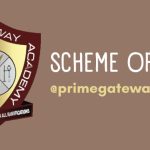JSS2 First Term Scheme of Work for Computer Studies
| ONDO STATE MINISTRY OF EDUCATION: UNIFIED SCHEMES OF WORK FOR JUNIOR SECONDARY SCHOOL | ||
| Computer Studies Scheme of Work for Junior Secondary School 2(JSS2) | ||
| Class | J.S.S 2 | |
| Subject | Computer Studies | |
| Term | First Term | |
| Week | Topic | Breakdown |
| 1 | REVISION ON CLASSIFICATION OF COMPUTERS | I. Sizes of Computers
II. Generation III. Degree of Versatility IV. Types |
| 2 | THE COMPUTER SYSTEM | Components of Computer System – Hardware, Software, People – Ware |
| 3 | HARDWARE COMPONENTS | I. Definition of hardware components
II. Input Devices III. Output Devices IV. Storage Devices V. Arithmetic and Logic Unit VI. Control Unit |
| 4 | SOFTWARE | I. Definition of Software
II. Types of Computer Software – System and Application Software III. Give Examples of Each Type of Computer Software |
| 5 | PEOPLEWARE | I. Define computer Professional
II. State the Types of Computer Professionals III. Give Examples of Computer Users |
| 6 | OPERATING SYSTEM | I. Definition of an operating system
II. Examples of Operating System – DOS, Window, Linux and Unix |
| 7 | FUNCTIONS OF OPERATING. SYSTEM | I. Resource allocation
II. System monitoring III. Utilities |
| 8 | NUMBER BASE | I. Decimal
II. Binary III. Octal IV. Hexadecimal |
| 9 | CONVERSION OF NUMBER BASES | I. Convert decimal to binary and vice versa
II. Convert decimal to Octal and vice versa III. Convert decimal to Hexadecimal |
| 10 | UNITS OF STORAGE IN COMPUTER | I. State the Various Units of Storage and their Values – Bits, Bytes, Nibble,
Kilobytes, Megabyte and Gigabyte II. Convert from One Unit to Another III. Differentiate between Kilometer, Kilogram, Kilowatt and Kilobyte. IV. Distinguish between kilobyte, Megabyte and Gigabyte |
| 11 | REVISION | |
| 12 | EXAMINATION | |
JSS2 Second Term Scheme of Work for Computer Studies
| Term | Second Term | |
| Week | Topic | Breakdown |
| 1 | REVISION ON PROGRAMMING LANGUAGE | I. Meaning of Computer Programming Language
II. Examples of Computer Programming Language – Logo, BASIC, COBOL, FORTRAN, etc. |
| 2 | BASIC LANGUAGE | I. State the Meaning of the Acronym BASIC
II. BASIC Character Set, Key BASIC Statements, Simple BASIC statements. BASIC LANGUAGE I. State the Meaning of the Acronym BASIC II. BASIC Character Set, Key BASIC Statements, Simple BASIC statements. |
| 3 | SIMPLE BASIC STATEMENT | I. Examples of Simple Statements
II. Write a Simple BASIC Program III. Run Simple BASIC Program |
| 4 | GRAPHIC PACKAGE I | I. Meaning of Graphic Packages
Ii. Examples of Graphic Packages – Paint, Corel Draw, Instant Artist, Photo Shop |
| 5 | FEATURES OF GRAPHIC PACKAGE | Title, Toolbar, Menu Bar, Printable Bar, Color Bar, etc |
| 6 | GRAPHIC PACKAGES II – PAINT ENVIRONMENT | I. Features of Paint Environment
II. Paint Tools and their Functions III. Use Paint to Draw and Color Simple Objects |
| 7 | ICT AS A TRANSFORMATION TOOL | I. Meaning of ICT (Information and communication technology)
II. Examples – Computers, Telephone (GSM), Cellular network, Television, Satellite Communication and Internet |
| 8 | BENEFITS OF ICT GADGETS | I. Timely, Better and Cheaper Access to Knowledge and Information, Speed up
Transaction and Processes, Causes Human Being to interact with other Worldwide II. Disadvantages – Job losses, Threatens other Areas/ Field of Human Endeavors, etc. |
| 9 | ICT GADGETS | I. The GSM (Call, Create, Send, Store, Retrieve and Read Messages on
GSM Sets) II. Differentiate between GSM, Fax Machines and Telephone. III. Create and Send Messages to one another using the GSM |
| 10 | ICT GADGETS | I. Fax machine (Send and Receive Fax Messages)
II. Telephone III. Create and Send Messages to one another using the GSM and Fax IV. Store and retrieve information on a GSM handset. |
| 11-12 | REVISION AND EXAMINATION |
JSS2 Third Term Scheme of Work for Computer Studies
| Term | Third Term | |
| Week | Topic | Breakdown |
| 1 | REVISION ON THE INTERNET | I. Definition of the Terms
II. Internet (The Largest Computer Network in the World) III. E – Mail Address (Electronic Mail Address) IV. World Wide Web (WWW) |
| 2 | INTERNET BROWSER | I. Microsoft internet Explorer, Netscope, Mozilla, etc
II. Creating E – Mail Account, Website Address, Open an Email |
| 3 | BENEFITS OF INTERNET | I. Information exchange, E – learning, e – Entertainment, Faster and Cheaper
II. Abuses of Internet – Fraud and Pornography |
| 4 | INTERNET ENVIRONMENT | I. Characteristics and Features of internet Environment
II. Uses of Internet |
| 5 | NETWORK GROUPS | I. Search Engines (Identify Different Network Groups)
II. List out different Search Engines |
| 6 | FILE SHARING | I. Definition of Network
II. Types of Network – Local Area Network (LAN), Metropolitan Area Network (MAN), Wide Area Network (WAN) III. Description of the Types of Network |
| 7 | COMPUTER ETHICS I | Responsible ways of the Internet –
I. Avoiding liquid dropping into the system, II. Using dust cover, III. Protection from power problem, etc |
| 8 | COMPUTER ETHICS II | Abuse/Misuse of computer –
I. Invasion of privacy, II. Computer virus, etc. |
| 9 | SAFETY MEASURES I | I. The Sitting Posture Using Anti – Glare Protector
II. Positioning of Monitor Base. |
| 10 | SAFETY MEASURES II | I. The use of Computer Laboratory
II. Sitting Arrangement in the Laboratory III. Care and Maintenance of ICT Gadgets |
| 11-12 | REVISION AND EXAMINATION |




